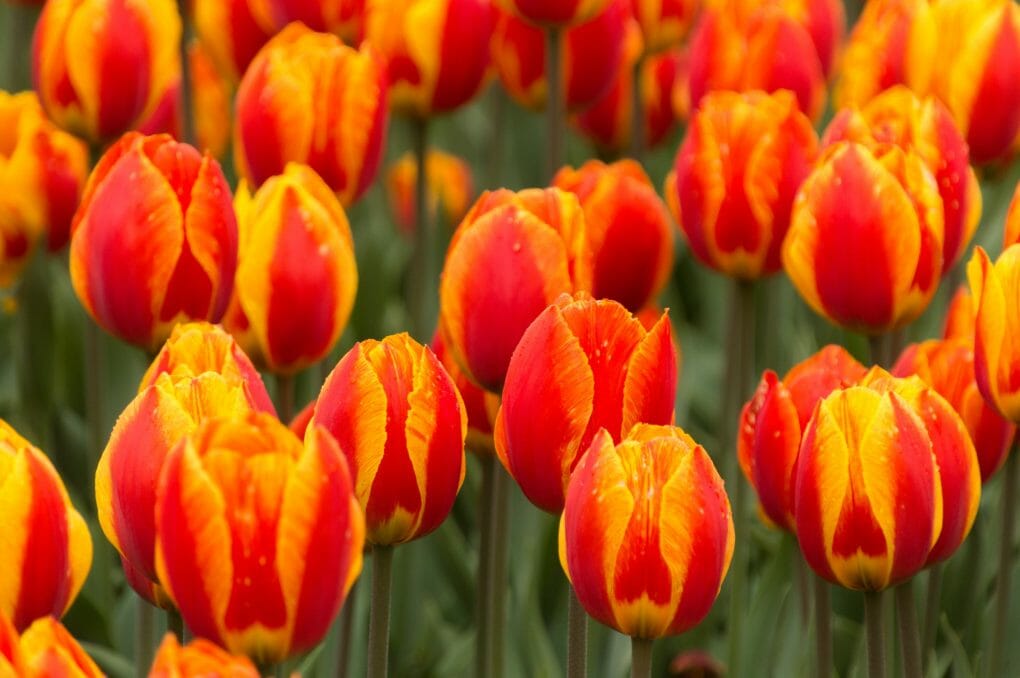What Animal Digs Up Tulip Bulbs? 10 Critters that Dig Up Your Tulip Bulbs
Tulips are gorgeous flowers in spring to enjoy. The tulip flower is a beautiful, delicate flower that has fascinated people for centuries. They last up to one to two weeks. Many different animals dig up tulip bulbs. The most common animal is the squirrel, which buries bulbs to eat their contents later. Other animals like digging up tulip bulbs include rabbits, raccoons, and chipmunks. Find out more critters in your garden and how to prevent them from digging your lovely tulip bulbs.
Table of Contents
12 Critters that Dig Up Your Tulip Bulbs
Snails & Slugs
The tulip bulb is an ideal snack for slugs and snails. Small critters love to munch on bulbs, destroying them in the process. So if you see any of these critters around your tulip bulbs, it’s best to get rid of them before they can do too much damage.

Look for these indicators if you think slugs or snails are to blame for tulip damage. They ragged holes in leaves. Slugs and snails prefer to eat plant leaves, except for a few unique plants like daffodils. According to the University of Maryland, Slugs and snails leave ragged holes in leaves. They use a foot that secretes mucus to help them move along. Tulip leaves may have silver streaks that show a snail or slug has been there.
If you are experiencing tulip damage, there is a good chance that slugs or snails are to blame. Slug and snail populations increase when the environment is damp, which we see during springtime in many parts of the world. Their reproductive cycle also involves eating plants, so if your flowers are being eaten near their roots, these pests likely are to blame.
To get rid of slug or snail populations on your property, try using nematodes (a worm) or baits made from sugar cane distillers and grains mixed with salt water. These can effectively control slug and snail numbers while leaving beneficial organisms such as spiders untouched. Keep in mind that this will only work if the population is high currently. Repeat applications may be necessary over time.
Deer
According to the University of Maryland, deer also can dig through tulip bulbs in search of food. Look for broken bulbs and dig around tulip plants to see if there is evidence that deer have been by. Deer rarely eat tulip bulbs themselves, but their dung occasionally contains dormant eggs from slugs or snails, which will hatch and start the pest problem all over again.
Rabbits
They also can eat tulip bulbs, and their digging can damage bulbils (the tiny flowers that grow on the stem of a tulip bulb). If you see rabbit tracks in your flower bed or near tulips, it might be time to call pest control professionals. They will be able to remove all the rabbits and prevent them from eating more bulbs! With their adorable long ears and fluffy white tails, rabbits appear everywhere. Tulips can be destroyed by rabbits, despite their cuteness. Rabbit damage can occur at any time of year. They can eat tulip leaves day or night and are active all year.
Rats and Mice
Rat damage can also occur if your tulips are planted near places where rodents live. Their digging can cause the bulbils to grow into flowers. They will dig around the bulbs for food and may even eat them themselves. If you see signs of rat activity near your tulip plants, call a pest control professional to remove all of the rats and prevent them from digging up any more bulbs!

Pigeons
Pigeons also can dig up tulip bulbs, though they are more likely to do so during the springtime. Look for broken bulbs and dung near tulips plants to see if pigeons have been by.
Moles
Moles are exciting pests because they can help control other problems. They burrow into the ground and eat insects, so by digging around tulip bulbs, they may be helping to prevent slug or snail damage. However, moles will also eat tulip bulbs if left unchecked, so it is essential to monitor them and remove any that dig up bulbs in your garden.
Voles
Voles are similar to moles in that they can eat various pests. However, voles also love to dig around bulbs.
Skunks
Skunks are another critter that can cause tulip damage. Their pungent odor can repel many garden pests but won’t work against skunks. These animals dig up bulbs to eat the underground part of the plant; if left unchecked, they will destroy all of your tulips.
Squirrels
Squirrels are natural diggers and often explore their surroundings, looking for food or shelter. When they find tulips (or any other flower), they may mistake them for trees or plants that can be eaten. In reality, tulips are not edible and contain toxic compounds that can harm the squirrel if consumed in large quantities. However, if appropriately processed and only eaten in small doses, Tulip-eating squirrels are likely doing themselves some good.
Chipmunks
Chipmunks are small rodents that live in North America. They love eating bulbs and often chew on them until they break open. They are also known to eat the sepals of tulips. This can leave tulips unattractive and susceptible to other pests or diseases.
Raccoons
They are known for their excavation skills and love digging up tulip bulbs. This practice is seen as vandalism in some areas, but it’s beneficial for the tulips since it helps them eliminate old roots and reduces competition among plants. Additionally, when raccoons eat flowers or bulb husks containing pesticides or other chemicals, they can avoid getting sick.
Strategies to Keep Critters Away From Your Tulip Bulbs
Fence Your Garden Properly
Prevent wild animals from digging up or destroying your bulbs by fencing them in properly. These could be wire cages or chicken wire fencing with a 6-inch mesh spacing. Place a wire mesh over each bulb before installing it into the ground; make sure there is enough space between fences for critters to move around but not escape.
Grow Some Unsavory Plants for Critters
If you want to deter critters from digging up your tulips, grow something they might not be interested in. Hyacinth or daffodils are good choices because they have thorns and can smell unpleasant to squirrels.
Install a Wildlife Repellent Device
Another deterrent is to install of a wildlife-repellent device. This product emits an unpleasant odor that squirrels and other animals don’t like.
Make Digging More Challenging
Create ditches or mounds around each bulb so that critters must dig much deeper to get to them. Cover the bulbs with gravel, soil, or mulch before planting. This will make digging more difficult, hurt their paws and be time-consuming.
Provide a Variety of Food Options

In addition to deterrents, ensure that your bulbs have various food options, so critters don’t get bored of digging up tulips. Fill small planting holes with water and add pieces of fruit, veggie scraps, or birdseed. Place these around the garden for squirrels and other rodents to find.
Install a Camera to Monitor Digging
If you want to ensure that no critters are digging up your tulips, invest in a camera and keep an eye on the footage. This way, you can catch any squirrels or other pests digging up bulbs and take appropriate action. Keep Your
Planting Area Clean
If critters are digging up tulip bulbs, they’re also likely to damage the plants. Keep your planting area free of debris, and ensure that all flower bulbs are firmly planted so they can’t be pulled out easily.
Use Scare Tactics
If all else fails, try using scare tactics. Place a loud and sudden noise near the bulbs or set up a scary-looking predator in the area to make critters think twice before digging.
